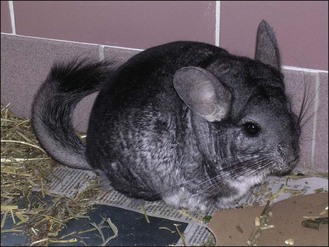6 Urolithiasis in a chinchilla
Introduction
Captive chinchillas should be maintained on a high-fibre diet. Commercial mixes for chinchillas may be low in fibre – often resulting in dental disease – and other constituents may vary significantly from the wild diet (Box 6.1). In these diminutive animals, treats should be quantified, as a small amount may be a considerable portion of the diet and result in nutritional imbalance. This case describes a condition that likely developed in response to an aberration of mineral content from the ideal diet.
Case History
The owner reported that the chinchilla (Fig. 6.1) had clinical signs for 3 days prior to presentation:
• Otherwise no problems were noted. The chinchilla was active, eating, drinking and passing faeces as normal.
Clinical Examination
• Resented abdominal palpation slightly; the owner suggested this was normal for this animal. The bladder appeared comfortable




